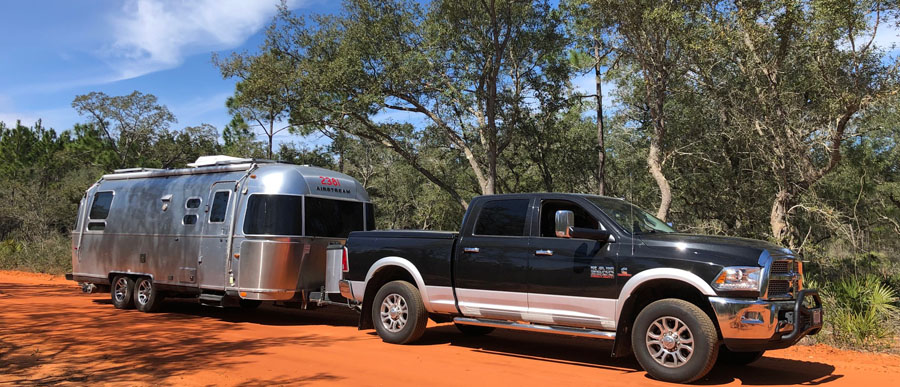
March 2019 - Airstream Electrical Heart Transplant
There comes a time in the sequence of Airstream upgrades that you have to undertake the mother of all upgrades! Ever since we stumbled through the cold nights and shortcomings of dry camping and boondocking in our Airstream, we have wanted to improve our outdoor wilderness endurance by adding solar panels and higher capacity batteries.After talking to many of our Airstreaming friends and fellow adventurers, we decided to contact Lew Farber of Solar Tech Energy Systems Inc - Lew is based in Naples Florida during the winter and Hood River Oregon during the summer. Lew gave us a quote for four roof mounted solar panels giving us 400 watts, a Victron solar controller, and a pair of Lifeline AGM 6 volt golf cart batteries wired in series to give us 300 amp hours. For total power management of the Airstream, we also added a Victron Energy 2 kW inverter relocating it under the starboard dinette berth so that it was in close proximity to the new batteries.
On day three of this five-day conversion, I visited our Airstream to review work in progress. Only then did I realize the magnitude of this upgrade! It can be best described as a heart transplant for Airstream electrical systems. Out go the Progressive Dynamics PD4655 converter and 12 and 120 volt distribution system as well as the old factory installed 1 kW inverter, to be replaced with a sophisticated inverter/converter, controllers, displays, isolators, and, of course, an app to monitor it all on your Bluetooth phone!
Previously, our 200 watt Zamp portable solar panel worked effectively when deployed, generating as much as 13.8 volts at 10 amps, allowing us to spend longer periods in wilderness locations. The down side was the inertia of setting up the panel for short stays, the significant 6 cubic feet amount of space in the truck bed occupied by the unit and its protective sleeve, and the necessity to realign the panel at least twice daily to follow the sun.
Battery upgrade:
Our former battery configuration of two 12 volt Lifeline AGM wired in parallel had a total rating of 160 Ah; in practice only 50% of that was usable to avoid damaging the batteries, and that was inadequate to run the furnace overnight. Moving to a pair of higher rated GPL-6CT six volt golf cart batteries wired in series gives us 300 Ah, however the size of the batteries, from group 24 to group 6, requires relocating the batteries to inside the Airstream forward under the starboard berth. AGM batteries are totally sealed so no gases are emitted during charging or discharge. The additional combined weight of these batteries comes in pretty close to 180 lbs, somewhat heavier than the prior 12 volt system. Locating them closer to the axles and trailer center of gravity lessens the anxiety about extra tongue weight.
Inverter upgrade:
The original Airstream installed 1 kW inverter was useful over the previous four years, providing light duty power to our TV and DVD player and keeping us entertained off the grid. It was never within its capability to operate any of our kitchen appliances such as coffee maker, toaster, blender or microwave as most of these appliances need 1,000 to 2,000 watts. The original inverter was located on the floor, close to the fridge. It was removed when building our drawer cabinet unit. The new location for the Victron Energy MultiPlus MPPT 3000 inverter is under the berth adjacent to the batteries, making the shortest possible run of 04 gauge 150 amp wiring.
Solar panel installation:
The solar panels were mounted on the roof using 3M VHB tape, two panels forward close to the main skylight and two more panels aft either side of the rear Fantastic fan. Each SP-100 panel is sized at 2 x 4 feet and is installed with four feet with adjustable mountings allowing panels to be elevated through 60 degrees longitudinally for optimum solar collection. We made sure the positioning of the solar panels would allow a future satellite dish to be mounted in the last available roof space in the rear over the bedroom. Wiring access to the panels was made through a combined box and a 2 inch hole in the top of the refrigeration cabinet roof. Cables were routed to the SmartSolar MPPT 100/30 controller through an isolator switch. The SmartSolar controller broadcasts performance data on Bluetooth when paired with your phone and gives you voltage and current generated from the photo-voltaic cells.
Energy systems management:
The inverter unit takes over many roles in the Airstream electrical configuration. It performs regulated battery charging, acts as a distribution control for all 120 volt and 12 volt services, and alternates seamlessly as a UPS between shore power 120 v and inverter 120 v. The Progressive Dynamics PD-4655 converter becomes redundant and can be removed. We elected not to connect some 120 volt circuits to the inverter (although technically we have the necessary capacity), specifically the air conditioning / heat pump unit, heated towel rail, fridge and the water heater. All other 120 volt circuits in the Airstream now are controlled by the inverter, so all outlets are live under either power scenario.
Inverter and battery performance are monitored through control panels mounted on the partition above the TV adjacent to the microwave cabinet. The battery voltage monitor BMV-712 shows battery voltage status and the digital multi control panel is the remote control for the inverter. All data is also available over a Bluetooth link to a phone app. A switch on the panel allows the inverter to be switched off, on, or charge only. An array of LED’s give a quick glance status and blink when conditions have moved outside predetermined parameters such as high discharge, overload, limited life of battery power, or temperature outside normal range.
After removing the old Progressive Dynamics converter, the 12 volt and 120 volt distribution panels were replaced with new separate Progressive Dynamics distribution panels, a PD6000 for the 12 volt DC circuits, which remain in an identical electrical configuration, and a separate PD55K003 split distribution panel for 120 volt AC circuits. The difference in the old and new AC configuration is based on which services will be inverter powered and which we deliberately plan to power only by shore power, such as water heater and air conditioning. The upper five distribution breakers support shore power only services and the lower five breakers default to shore power but kick over to inverter automatically when the UPS takes over under dry camping situations.
Management of power is still a challenge for extended dry camping, but continuous solar recharging along with judicial use of our propane converted Honda generator make for a comfortable and sustainable lifestyle. The two Victron Energy Apps on our phones give probably too much detailed analysis of power consumption offset by solar or generator charging. Two items grab your attention: Battery State of Charge as a % of total capacity, and Time Remaining representing how many hours or days your system can support you!
We love spectacular scenery and quiet campgrounds by the water. With these new solar resources, we look forward to enjoying a wider array of sites for extended camping. We look forward to reporting our discoveries next year!
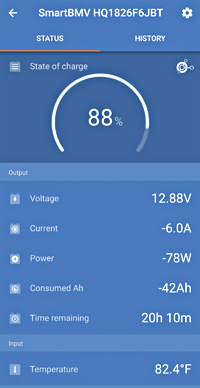 |
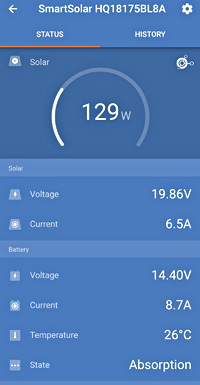 |
|
| Victron smartphone app shows the system status, battery voltage, current in amps and watts being drawn, amp/hours used since last charge and battery time remaining with current load. | Solar controller Bluetooth monitor app showing panel generated voltage and conditioned output voltage now charging the batteries. Temperatrure monitoring is provided in case of intense conditions. |
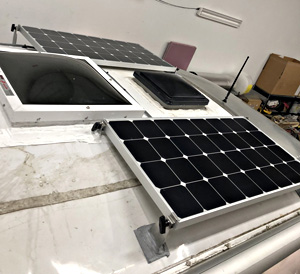
Four 100 watt solar panels installed on the roof of our Airstream, 2 forward and 2 in the rear.
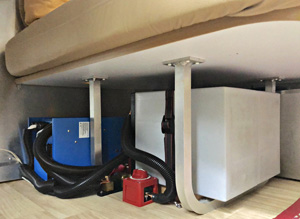
The heart of the system: the blue box is the Victron inverter, red master battery isolator switch, and two GPL-6 golf cart batteries mounted on their ends.
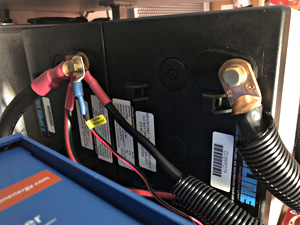
Front end of batteries showing the 4 gauge wiring to the inverter.
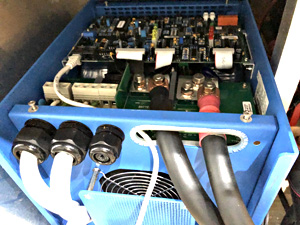
The inverter under the dinette berth – input 12 volt black cables from batteries on right, incoming shore power and outgoing 120 volt to distribution panel on left.
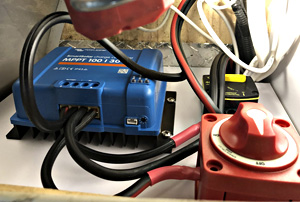
Solar panel controller moderates the widely fluctuating solar voltage to a nominal 12 to15 volts for battery charging.
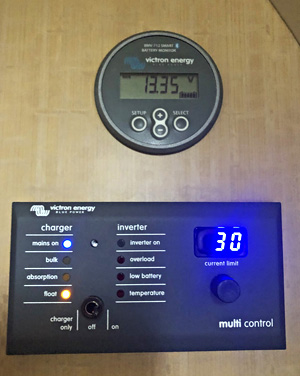
Victron display for battery status and inverter control panel with status and warning LED’s.
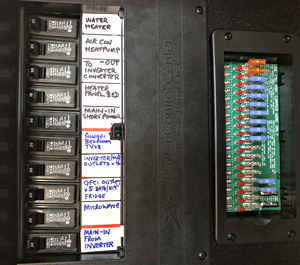
Distribution panels for DC (right) and AC showing split shorepower breakers (top 5) and inverter fed breakers (bottom 5).
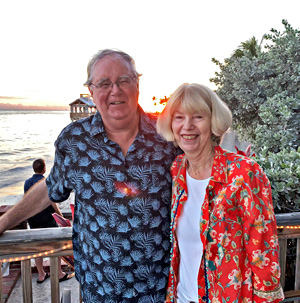 Margaret & David Broad (WBCCI #2381) from Tappahannock Virginia, traveling 8 months of the year since July 2016 in their 2015 Flying Cloud 25 RB enjoying sunset in Key West FL. You can email questions or comments to airstream@db26.net Their travel blog is at www.flyingcloud25.blogspot.com and David also publishes an Airstream improvement page at www.facebook.com/airstreamtweaks |